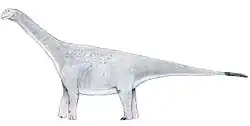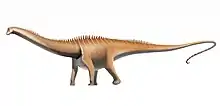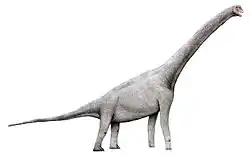| Rugocaudia Temporal range: Early Cretaceous, | |
|---|---|
| Scientific classification | |
| Domain: | Eukaryota |
| Kingdom: | Animalia |
| Phylum: | Chordata |
| Clade: | Dinosauria |
| Clade: | Saurischia |
| Clade: | †Sauropodomorpha |
| Clade: | †Sauropoda |
| Clade: | †Macronaria |
| Clade: | †Titanosauriformes |
| Genus: | †Rugocaudia Woodruff, 2012 |
| Type species | |
| †Rugocaudia cooneyi Woodruff, 2012 | |
Rugocaudia is a potentially dubious genus of basal titanosauriform sauropod dinosaur known from the Early Cretaceous of Montana, United States.[1]
Discovery
Rugocaudia is known only from the holotype MOR 334, a partial postcranial skeleton which consist of 18 caudal vertebrae and associated material including isolated neural arch, tooth, chevron, and distal section of a metacarpal. It was collected from the Cloverly Formation, dating to the Aptian or the Albian stage of the Early Cretaceous.[1]
Validity
Rugocaudia is considered to be a nomen dubium by D'Emic and Foreman.[2]
Etymology
Rugocaudia was first described and named by D. Cary Woodruff in 2012 and the type species is Rugocaudia cooneyi. The generic name is deriverd from Latin ruga, "wrinkle" and cauda, "tail" in regards to the highly rugose posterior margins of the caudal vertebrae. The specific name honors the land owner J.P. Cooney.[1]
References
- 1 2 3 D. Cary Woodruff (2012). "A new titanosauriform from the Early Cretaceous Cloverly Formation of Montana". Cretaceous Research. 36: 58–66. doi:10.1016/j.cretres.2012.02.003.
- ↑ d'Emic, Michael D.; Foreman, Brady Z. (2012). "The beginning of the sauropod dinosaur hiatus in North America: insights from the Lower Cretaceous Cloverly Formation of Wyoming". Journal of Vertebrate Paleontology. 32 (4): 883–902. doi:10.1080/02724634.2012.671204. S2CID 128486488.










